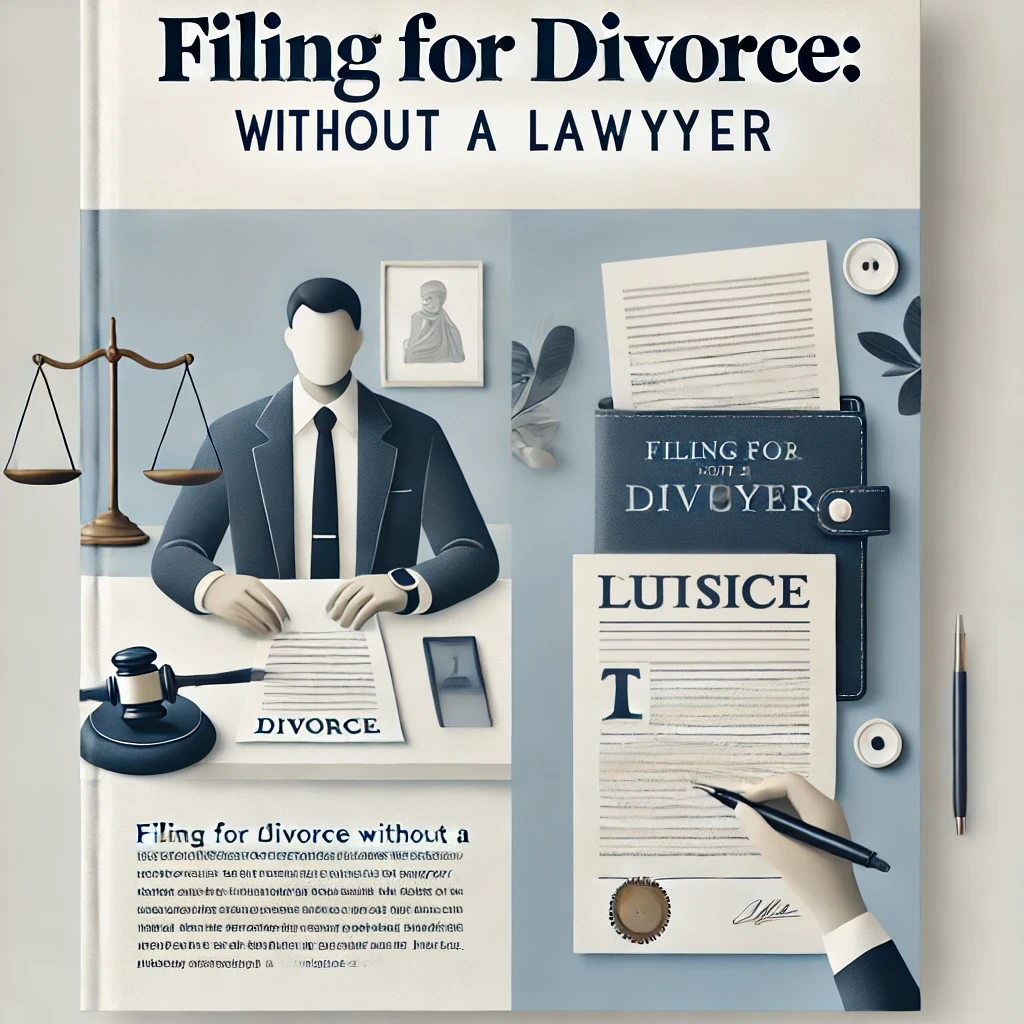
Can You Get a Divorce Without a Lawyer? A Step-by-Step Guide
Understanding the Possibility of Self-Representation in Divorce
The thought of going through a divorce can be overwhelming, especially when contemplating whether to hire a lawyer. Many individuals find themselves wondering if it is possible to navigate the divorce process without legal representation. The answer is yes; you can get a divorce without a lawyer. However, this route requires a thorough understanding of the legalities involved, as well as meticulous attention to detail. In this comprehensive guide, we will explore the options available for self-representation during divorce, the steps to take, potential pitfalls, and when it may be beneficial to seek legal counsel. Whether you are considering a divorce or are already in the process, this blog aims to provide you with valuable insights and practical steps to empower you in your journey.
Key Takeaways on Divorcing Without a Lawyer
- Self-Representation is Possible
- Understand Your State's Laws
- Gather Necessary Documentation
- Consider Mediation
- Know When to Seek Help
Many individuals successfully navigate the divorce process on their own.
Each state has different regulations regarding divorce; familiarize yourself with yours.
Organize financial records, custody arrangements, and any other relevant documents before proceeding.
Mediation can be an effective way to resolve disputes without going to court.
If the divorce process becomes complicated, don’t hesitate to consult a lawyer for guidance.
Step-by-Step Guide to Filing for Divorce Without a Lawyer
- Step 1: Understand Your State's Divorce Laws
- Step 2: Gather All Necessary Documentation
- Step 3: Complete the Divorce Forms
- Step 4: File Your Divorce Petition
- Step 5: Serve Your Spouse with the Divorce Papers
- Step 6: Attend Mediation or Court Hearings
- Step 7: Finalize Your Divorce
Before you begin, research your state's divorce laws. Each state has unique requirements regarding residency, grounds for divorce, and documentation needed. Familiarizing yourself with these laws can save time and potential legal headaches.
Collect all relevant documents such as marriage certificates, financial statements, tax returns, and any legal agreements related to property or custody. This documentation will be crucial for filling out the required forms and establishing your case.
Visit your state’s court website to find the necessary divorce forms. Fill them out with precision. Ensure that you include all required information, as incomplete forms can lead to delays in your case.
Once your forms are completed, file them at your local courthouse. Be prepared to pay a filing fee or request a fee waiver if you are unable to afford it. After filing, you will receive a case number to track your divorce proceedings.
You must legally notify your spouse of the divorce filing. This is typically done through a process server or by certified mail. Ensure you follow your state’s specific rules for service to avoid complications.
If you and your spouse cannot agree on specific issues, mediation may be required. If mediation fails, be prepared to attend court hearings. Stay organized and present your case clearly to the judge.
Once all issues are resolved, the court will issue a final decree of divorce. Review this document carefully to ensure it reflects the agreements made during the process. Keep a copy for your records.
Legal Insights and Common Pitfalls in Self-Representation
Navigating a divorce without a lawyer can be empowering, but it comes with its own set of challenges and legal considerations. One major pitfall is the risk of overlooking crucial legal requirements. For instance, many individuals fail to understand the difference between contested and uncontested divorces, potentially leading to unnecessary complications. A contested divorce, where spouses cannot agree on terms, may require court interventions that can be time-consuming and costly. Additionally, failing to accurately complete forms may result in dismissals or delays in proceedings. It's also vital to consider the implications of decisions made during the divorce, especially concerning child custody and support. A lack of legal guidance may lead to unfavorable terms that could impact your long-term financial security or relationship with your children. Furthermore, many individuals underestimate the emotional toll of divorce, which can cloud judgment and lead to hasty decisions. To mitigate these risks, thorough research and understanding of state laws are essential. In some cases, consulting with a lawyer for a brief consultation can provide clarity and direction, even if you opt to proceed without full representation.

Real-Life Examples of Successful Self-Representation
- Case Study 1: Sarah's Uncontested Divorce
- Case Study 2: Mark's Complex Divorce
Sarah and her spouse had been married for ten years and decided to part ways amicably. They both agreed on terms regarding property division and child custody. Sarah researched her state's divorce laws, filled out the necessary forms, and filed for an uncontested divorce. By maintaining open communication and focusing on their children's best interests, they successfully navigated the divorce without needing legal representation. This case highlights the potential for amicable resolutions when both parties are willing to collaborate.
Mark initially attempted to represent himself in a contested divorce involving significant assets and disagreements over child custody. As the process unfolded, he encountered challenges in legal terminology and court procedures. After several hearings, he realized he needed professional assistance. Mark consulted with a lawyer who provided strategic advice and helped him navigate the complexities. Ultimately, while he had begun the process alone, enlisting professional help proved essential for achieving a fair outcome. Mark's experience illustrates that while self-representation is possible, understanding when to seek help is crucial.
FAQs
- Can I file for divorce without a lawyer?
- What forms do I need to fill out for a divorce?
- How long does the divorce process take without a lawyer?
- Are there any risks associated with self-representation?
- When should I consider hiring a lawyer?
Yes, you can file for divorce without a lawyer. Many individuals choose to self-represent, especially in uncontested cases where both parties agree on terms. It’s crucial to research your state’s laws and procedures to ensure you meet all requirements.
The forms required for divorce vary by state. Typically, you will need a divorce petition, financial disclosures, and, if applicable, child custody agreements. Visit your local court's website for specific forms and guidance.
The duration of the divorce process can vary significantly. An uncontested divorce can take anywhere from a few weeks to several months, while contested cases may extend for a year or more due to legal complexities and court scheduling.
Yes, there are risks. Self-representation can lead to mistakes in paperwork, misunderstandings of legal terminology, and inadequate knowledge of courtroom procedures. These issues may result in delays or unfavorable outcomes. It’s essential to be well-informed and organized.
Consider hiring a lawyer if your case involves complex issues such as high-value assets, child custody disputes, or if communication with your spouse is fraught with conflict. A lawyer can provide clarity and strategic guidance to navigate the legal landscape effectively.
Additional Resources for Divorce Information
For further assistance on navigating the divorce process, consider visiting the following resources: Your state’s family court website, local legal aid organizations, and divorce support groups. These resources can provide valuable information, guidance, and support during this challenging time.
Final Thoughts on Self-Representation in Divorce
Choosing to get a divorce without a lawyer is a significant decision that can be both empowering and challenging. By understanding the process, gathering the necessary documentation, and being aware of legal pitfalls, individuals can effectively navigate their divorce. While many find self-representation manageable, it is crucial to know when to seek professional help. Ultimately, prioritizing clear communication and the well-being of any children involved can lead to a more amicable and smoother transition during this life change. Remember, you are not alone in this process, and seeking support is always a wise choice.
Need Assistance with Your Divorce?
If you're feeling overwhelmed or need guidance regarding your divorce process, don't hesitate to contact Lex Harper for expert advice. Visit our website for more resources and support tailored to your unique situation.





Comments